

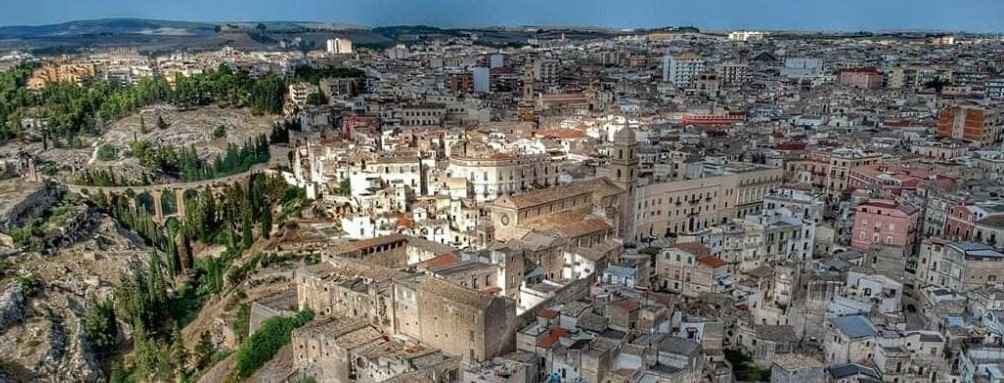


Being part of the Alta Murgia National Park, an unsuspected pearl of the Apulian territory stands out: Gravina in Puglia. Its name, Gravina derives from the deep split in the landscape, similar to canyons, the ravines, where the city is located. Still, the formation process is traceable on the calcareous bank where part of the city was founded on the edge of a deep crevasse.

The countryside of Gravina in Puglia, presents some sporadic settlements of the Neolithic and Bronze Age and close to the town of Gravina, on the "Colle di Botromagno", with over 400 hectares there is a settlement that today constitutes a real "archaeological park".
The archaeological area on the top of the Botromagno hill was already known at the beginning of the 20th century for the remains of a double rampart enclosing the remains of an ancient city. During the 30's, the blocks of the walls together with the architectural elements of the houses and tombs were reused for the construction of dry stone walls and rural buildings. The looting of burials intensified more frequently from the 1950s and obliged the then superintendent to ask for the intervention of the British School to start a study campaign aimed at discouraging the activity of looters, through the identification of areas of particular interest to be monitored. Later an archaeological park was planned including the ravine and the rocky village along it.

From the Iron Age on, a large inhabited area occupied the Botromagno hill and the Gravina ridge (Santo Stefano area). This period is witnessed by huts and fragments of pottery painted in the Apulian protogeometric style common to areas of Puglia and Basilicata. At the end of the VIII century B.C. the first imports of Greek geometric ceramics were dated to become more frequent from the mid-7th century. B.C. until being replaced, during the 6th century BC, by imitations of large local workshops. From the end of the seventh and throughout the sixth century. B.C. the huts are replaced by square or rectangular houses covered with tiles and sometimes adorned with architectural terracottas. Under the influence of Greek products, the decorations on locally produced ceramics went through major changes: this cultural phase is called Peucetian from the name the Greeks gave to the ancient inhabitants of the area, precisely, Peucetii. The excavations have revealed, in addition to dwellings, numerous burials that denote, from the quality of the objects of the grave goods, a wealth and a widespread well-being.
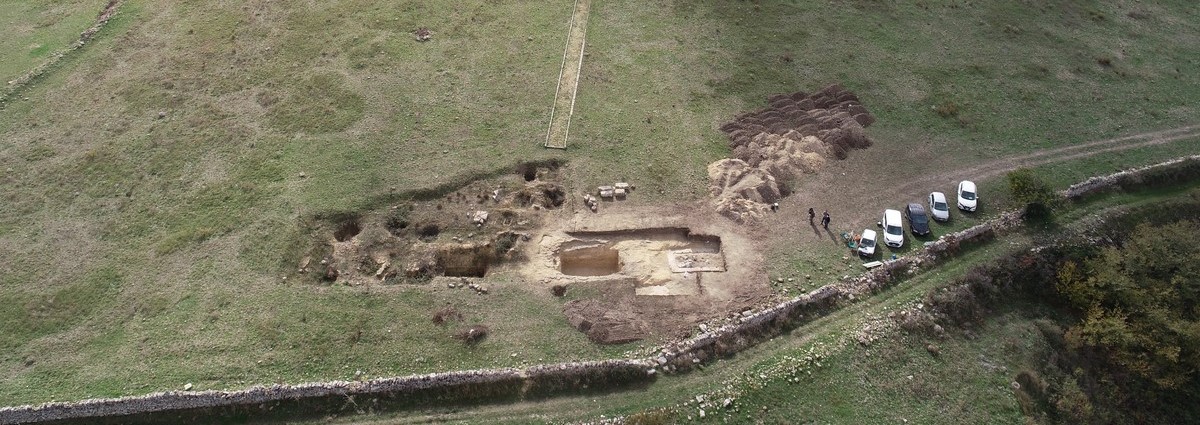
In the 5th century B.C. imports of Attic red-figure pottery were found, later supplanted by Magna Graecia productions, sought after for the refinement of the decorations. Among the most significant pieces, it is worth mentioning a kantharos quite singular in the shape, foreign to the Attic repertoire, decorated with a scene inspired by the Iliad and illustrated by inscriptions. With the IV sec. B.C. the city extends to occupy the area of the present town, as evidenced by the finds in Via San Vito Vecchio and in other areas of the city. The houses, almost all replaced by those built in the second century BC, have a very articulated layout and often overlook paved streets.

Ditched and semi-chambers tombs are flanked by chamber tombs preceded, sometimes by a dromos. In ceramics, the taste for over-painted decorations and the shapes borrowed from the repertoire of metallic pottery were often found: this new phase, called Apulian from the name used by Roman writers, is the richest in testimonies from burial objects. The massive walls surrounding the archaeological park and the first coin issues with legend (Sydyon from the ancient name of Gravina) minted by a local mint are dated to this period.

The war events of the end of the 4th century and the beginning of the 3rd century occured to be catastrophic: during the second Samnite war (326-304 BC), the city was garrisoned by Samnite troops and besieged by the Romans (306 BC). After storming it the Romans will make slaves 5000 Sydyon inhabitants. As if this were not enough, a few years later, the city was besieged again and this time conquered by the Epiroteans of Pirrus (280-275 BC). The fortunes of the Peucetian city did not change got worse with the Hannibal wars and with the defeat of the Carthaginian general, Sydyon along with most of the centers that had lined up for Hannibal, were punished by the Romans with confiscations and expropriations and the decline was inexorable. During the II and the I sec. to. C. throughout the territory there are several villas (Roman agricultural estates), sometimes with rooms plastered and painted, as in the Vagnari district.

It is probable that in this phase only the station of Silvium (Roman name of Sydyon) survived, along the Appian Way, but the location of the station is still uncertain. Along the Gravina torrent it is also possible to visit the "Padre Eterno" area where there are numerous pit burials dating from the end of the 7th to the end of the 4th century. a.C., some spaces and an area occupied by furnaces for the production of vases and bricks.
However, the most interesting archaeological area is Botromagno. The access from the road in front of Parco Bruno is advisable, as it follows, in part, the route of the walls of late 4th century B.C. On the hill half-chamber plastered and painted tombs are visible, dating the fifth century. a.C., a chamber dug into the rock with dromos dating back between the 4th and 3rd centuries. B.C. and the remains of houses among which a large villa of the first-second century a.C. with a small room covered with painted plaster.

The Botromagno hill is not the only point of interest that Gravina can offer. Its characteristics make it very similar to the nearby Matera, as matter of a fact both of them developed along a karstic canyon of the Murgia plateau - the Gravine (ravines) - and the presence of a highly workable and easily extractable rock allowed the development of both inhabited centers since the early Middle Ages. Similar urban developments are widespread throughout the entire Apulian territory which also Matera was part until the 17th century.

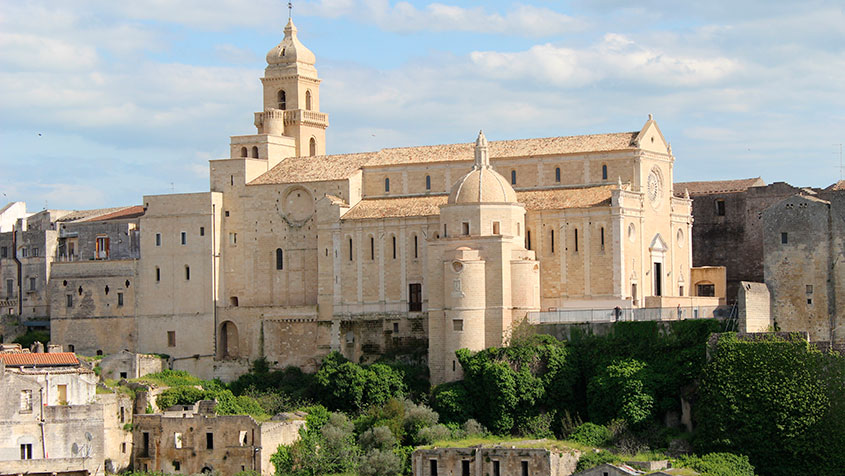 Near the ravine, there is an incredible architectural marvel, the Co-Cathedral of Santa Maria Assunta. Besides being the main Catholic worship place of Gravina in Puglia, this building belonging to the Norman age, is a true masterpiece, so much so that it was consecrated in 1993 by Pope John Paul II as a minor basilica. Built, as already mentioned by the Normans around the year 1000, the Co-Cathedral of Santa Maria Assunta has seen throughout its (almost) millennial history numerous modifications and additions that have today made it an obligatory stop for all the devotees and not, willing to visit the city.
Near the ravine, there is an incredible architectural marvel, the Co-Cathedral of Santa Maria Assunta. Besides being the main Catholic worship place of Gravina in Puglia, this building belonging to the Norman age, is a true masterpiece, so much so that it was consecrated in 1993 by Pope John Paul II as a minor basilica. Built, as already mentioned by the Normans around the year 1000, the Co-Cathedral of Santa Maria Assunta has seen throughout its (almost) millennial history numerous modifications and additions that have today made it an obligatory stop for all the devotees and not, willing to visit the city.

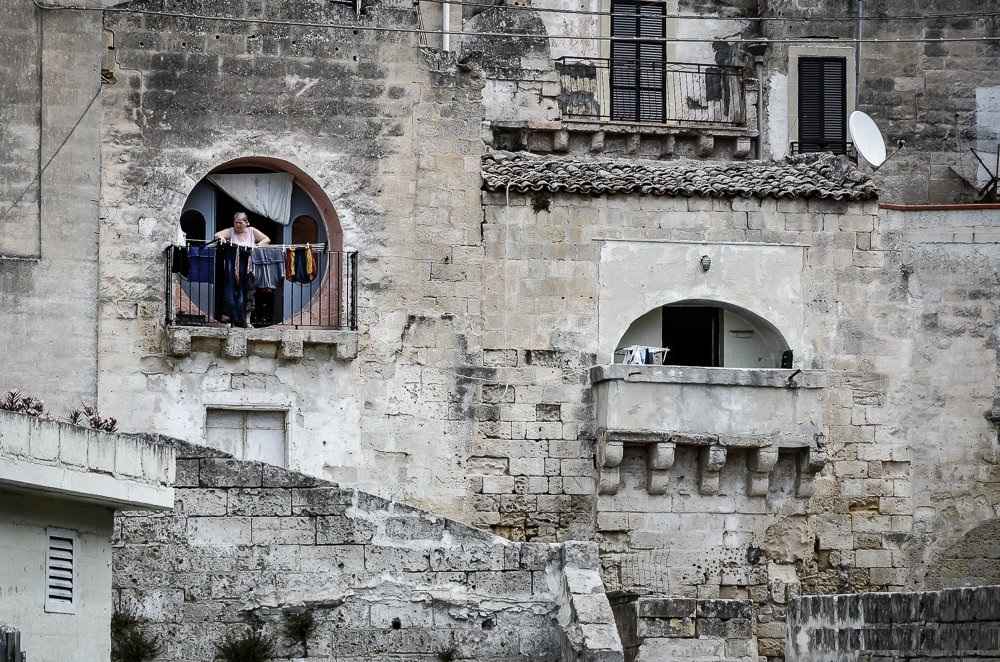 Piaggio and Fondovico wards
Piaggio and Fondovico wardsThese two districts are the historic heart of the city where many of Gravina's attractions are concentrated. Piaggio and Fondovico can also very amusing by taking just a stroll among the narrow alley overlooking old ladies hanging out laundry or where the lunch smells pervades the streets
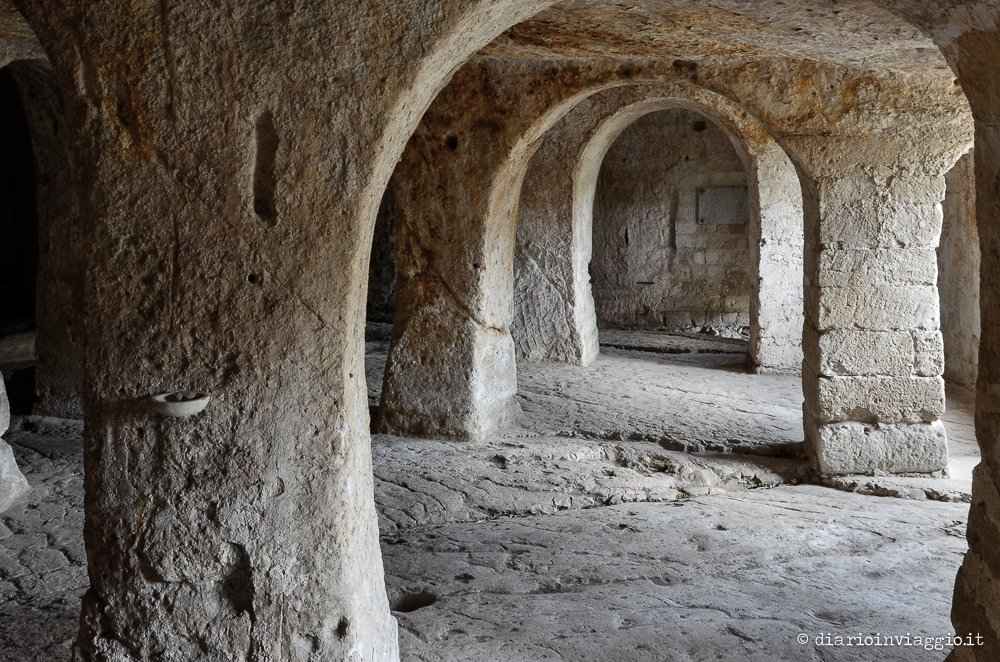 Church of San Basilio Magno
Church of San Basilio MagnoThe church of San Basilio is located in the Piaggio district and it is carved out of stone with eight columns and an altar where an icon of Mary is placed: its presence in the town would be almost unnoticed if it were not for the old bell tower in tufo that soars.
The church was for a long time a place of worship for the town inhabitants then it was closed, unused and desecrated for many years.
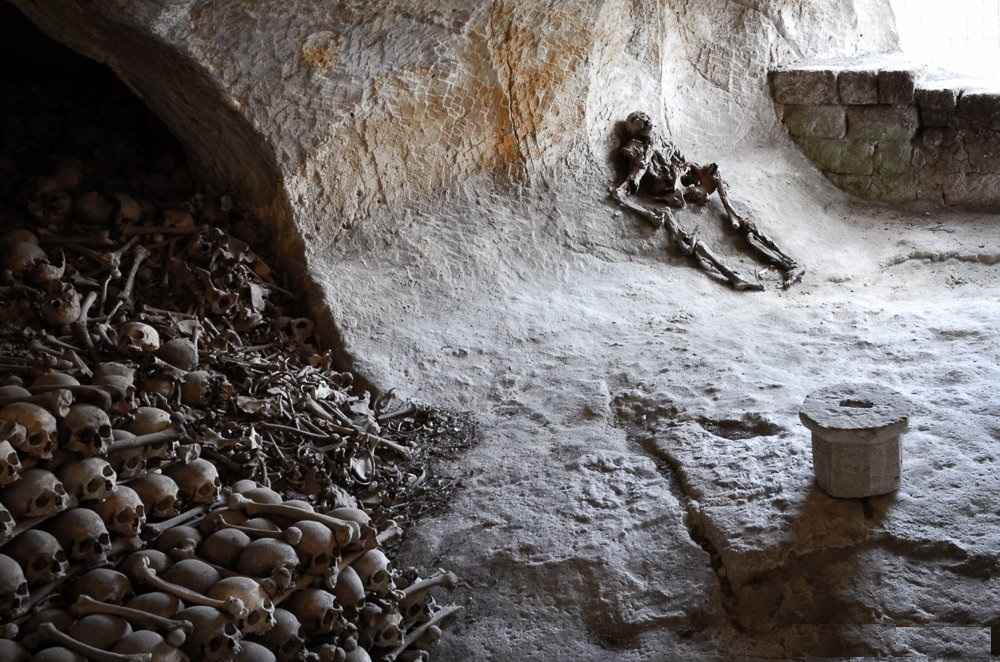 The Rupestrian Church of San Michele delle Grotte
The Rupestrian Church of San Michele delle GrotteIt is a church entirely carved into the rock: the aisles, columns and arches are carved into the tuff and some frescoes in the altar area are still visible. In the adjoining room there are heaps of skeletons and bones with a rather disturbing aspect: according to the legend they are the martyrs of the Saracen attack which took place around the year 1000. From here you can turn your gaze to the ravine which offers a remarkable view of the ravine and the seven chambers rupestrian complex.
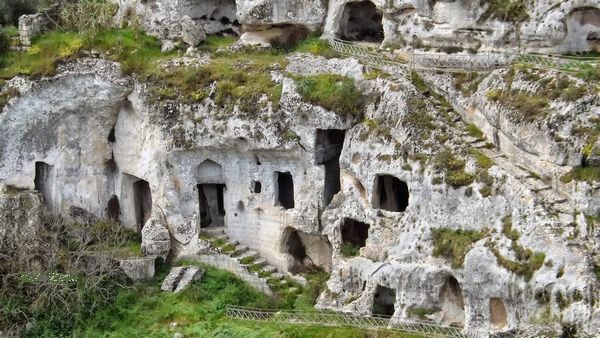 The Seven Rooms Rupestrian Complex
The Seven Rooms Rupestrian ComplexThis complex of tunnels dug out of tufo is located on the west side of ravine and can be easily admired from the Fondovico district. Nothing more than openings in the rock similar to dark windows that give an inkling that on the other side of the canyon there are ancient settlements dating back late Middle Ages.
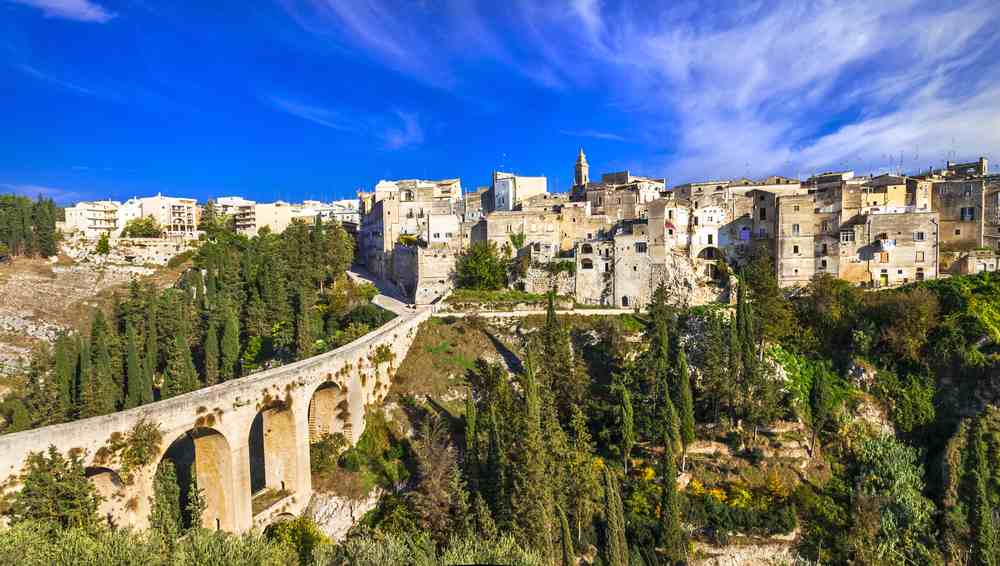 Viaduct Aqueduct Bridge on the Gravina creek
Viaduct Aqueduct Bridge on the Gravina creekAn arched structure 90 meters long and 37 meters high connects the two sides of the city. Suspended above the Gravina stream, it was built to allow easy access for the devotees from the historic center (Piaggio and Fondovico districts) to the Church of the Madonna della Stella on the opposite side
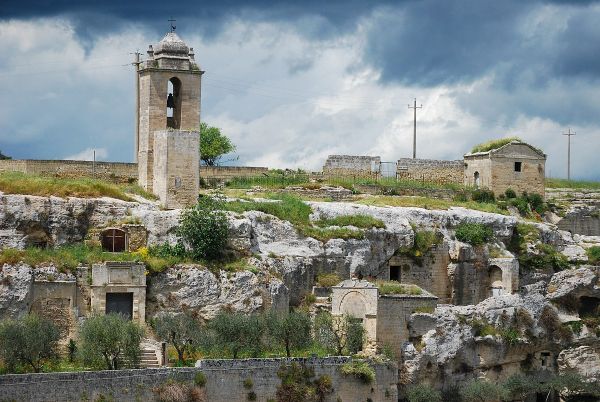 Sanctuary of the Madonna della Stella crypt
Sanctuary of the Madonna della Stella cryptLegend says that in this area a fresco was found depicting a Madonna with child with a star painted on her head, therefore a church was set up to become an important pilgrimage destination for sick people and women who could not get pregnant. Excavated also in the tufo, in the past it was probably covered with frescoes that unfortunately did not resist time

Particularly interesting is the collection of objects from the Botromagno excavations on permanent display in the "Aristocrazia e mito" exhibition at the Ettore Pomarici-Santomasi Foundation Museum in Gravina in Puglia.
The "Ettore Pomarici Santomasi" Foundation, located in the heart of the ancient city, was set up in Moral Institution in 1920, just three years after the death of Baron Pomarici Santomasi who donated to his city his Palace and the Goods contained therein to become Museum and Library. Of absolute artistic interest, the Crypt of San Vito Vecchio, a great example of medieval rock art, rebuilt here in 1968, after detachment from a local rock church.
Furthermore, archaeological finds from the Peucetian era are kept inside.


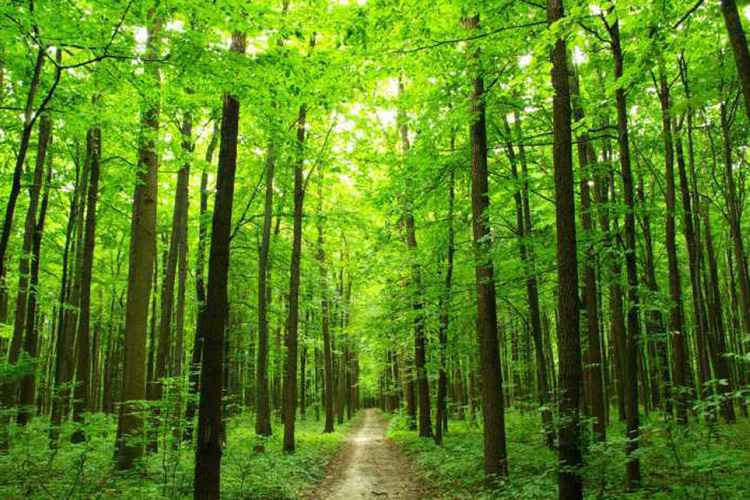 The Bosco "Difesa Grande", with its approximately 2000 hectares, is one of the most important wooded complexes in the whole of Puglia. Located 6 km from the town of Gravina, in the middle water catchment area of the Bradano river. It extends over hilly terrain between the Gravina torrent to the east and the Basentello torrent to the west, both tributaries of the Bradano river. The geological structure consists essentially of a thick layer of sand and Pleistocene conglomerates, formations dating back to the last period of the Quaternary era. In the debris blanket the following formations can be distinguished: Conglomerates of Irina and Sabbie dello Staturo, supporting the Sands of Monte Marano and the Clays of Gravina. The municipal forest at the time of the Swabian dominance was called Selva or Foresta.
The Bosco "Difesa Grande", with its approximately 2000 hectares, is one of the most important wooded complexes in the whole of Puglia. Located 6 km from the town of Gravina, in the middle water catchment area of the Bradano river. It extends over hilly terrain between the Gravina torrent to the east and the Basentello torrent to the west, both tributaries of the Bradano river. The geological structure consists essentially of a thick layer of sand and Pleistocene conglomerates, formations dating back to the last period of the Quaternary era. In the debris blanket the following formations can be distinguished: Conglomerates of Irina and Sabbie dello Staturo, supporting the Sands of Monte Marano and the Clays of Gravina. The municipal forest at the time of the Swabian dominance was called Selva or Foresta.
During the seventeenth century, the University (term used to indicate the Municipality) purchased the wooded surface in question from the Royal State which had already taken the name of "Difesa Grande", becoming an asset of the Municipality. The term "Defense" originally meant prohibition and, in a broad sense, could also indicate an area subject to particular prohibitions and therefore to a particular regime of use. Within it, only civic uses of wood and gland were allowed. Defense or like its synonym bandit or banned place, meant "a place that could not be more divided, enjoyed in particular by the communists, but had to remain the property of the state; and therefore, if it was not wooded, it necessarily had to be reforested. "

In conclusion, no one could break it up or even usurp it. The wood had always been experienced as a source of wood supply for the Gravina community. By consulting the preliminary documents and appreciation of the Municipality of Gravina in the year 1754, for the formation of the cadastre, it was certified that the aforementioned University of Gravina owned "the following Goods, Annuities and Gabelles and has the following Universal Weights": «A Wood of arbores of cerse called the Grande Difesa with a capacity of eighty-four carriages, in which the poor have the ius of wood in the neck seu to the collar only ... which is of ducats six in soma, bordering the said forest seu Difesa Grande colli properties of the Venerable Monastery of S. Maria delle Domenicane, called the Rifezza of Pied'organo ... "" (Library "Ettore Pomarici Santomasi", Gravina).

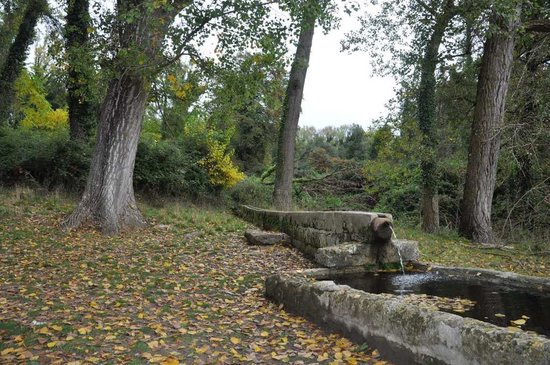 Herding was closely related to the woods. Here too there are numerous writings that testify to attempts to reconcile the needs of the forest with those of the shepherds and the load of cattle present in large numbers in the woods. The Archives revealed a cross-section of Gravina's life that began in the early 1900s and ends until the threshold of the second millennium. Difficult years, marked by widespread misery that affected the majority of the population. Hence the importance of the forest, as a source of supply and herding, a social and economic thermometer.
Herding was closely related to the woods. Here too there are numerous writings that testify to attempts to reconcile the needs of the forest with those of the shepherds and the load of cattle present in large numbers in the woods. The Archives revealed a cross-section of Gravina's life that began in the early 1900s and ends until the threshold of the second millennium. Difficult years, marked by widespread misery that affected the majority of the population. Hence the importance of the forest, as a source of supply and herding, a social and economic thermometer.
The wood represents a residual testimony of the luxuriant Mesophyte forest that covered most of these districts. The part of oak is mainly formed by three species of deciduous trees: downy oak (Quercus pubescens s. L.), Turkey oak (Quercus cerris L.) and farnetto (Quercus frainetto Ten.). Of the approximately 2000 hectares, almost 350 hectares consist of coniferous reforestation with predominant pine (Pinus halepensis Mill) and cypresses (Cupressus sempervirens L, and Cupressus arizonica Grecene).

In the arboreal plan there are other broad-leaved trees such as the ash (Fraxinus ornus L.), carpinella (Carpinus orientalis Mill.), Minor maple and field maple (Acer monspessulanum L. and Acercampestre L.), the shrubby or arboreal species that more frequently they are found are, depending on the areas, the rowan (Sorbus domestica L.), dogwood (Corpus mas L.) hawthorn (Crataegus monogyna Jacq.), privet (Ligustrum vulgare L.), perazzo (Pyrus amygdaliformis L.), fillirea (Phillyrea angustifolia L. and P. latifoglia L.), elm (Ulmus minor Mili), juniper (Juniperus oxicedrus L.), broom (Spartium junceum L.). The undergrowth mainly consists of mastic (Pistacia lentiscus L.), butcher's broom (Ruscus aculeatus L), smilace (Smilax aspera L.) and cistus (Cistus salvifolius L. and Cistus incanus L.). The forest has always been governed as a forest with irrational choice treatment and coppice matriculated with shifts for 15 years in order to obtain firewood, branches and acorn for farm animals.

Although there are no limestone outcrops, typical of the Murgia, the forest is part of this geographical region. Murgia is a region which has been strongly and long humanized; man therefore played an important role in determining the fauna structure both through the changes made (reclamation, deforestation) and as a direct translocator of species. To these factors which over time had given their own and characteristic face to our fauna heritage, more and more accentuated dynamism elements were added which negatively influenced it. As a result we are moving towards a generalized and rapid impoverishment of the various fauna complexes that can be identified in our region. For some environments, such as that of the "Difesa Grande" forest, the loss of naturalness was not so drastic, with a strong conservation of diversity in species, consequent to naturally created environmental conditions, suitable for hosting a multitude of species and varieties of animals. Encounters are not uncommon. If you go along the paths you can come across harmless reptiles such as the green lizard (Lacerta viridis), the largest European saurian, the smooth snake (Coronella austriaca), or the Hermann's turtle (Testudo hermanni), the smallest of the three species that populate Southern Europe; running into a hare or a fox looking for food in the dense forest vegetation is not such a rare event. The fauna complex is very rich thanks to a massive ornithic frequency of forest species, most of which nesting, included in the regulations and Red Lists of safeguard, we mention in this sense: the cuckoo, the barn owl, the red kite and the black kite brown, the buzzard, the scops owl, the hoopoe, the common owl, the tawny owl, the blackbird, the blackcap, the sparrow hawk, the jay, the calender, the redhead.

Among the mammals we mention the wild boar, the weasel, the badger, the skunk, the porcupine, the marten, and the increasingly rare wild cat. In addition to the reptiles already reported, the common snake (Coluber viridiflavus), the cervone (Elaphe quatuorlineata), the snake of Aesculapius (Elaphe longissima), the aspid viper (Vipera aspis), the collared natrix (Natrix natrix), the luscengola , the gecko and the tarantula of the walls. In an area characterized by few stagnations of rainwater, the presence of species of amphibians, such as the Italian newt and the crested newt, the common and emerald toad, the green frog and the agile frog, the tree frog and the ululone is quite rich yellow-bellied, all species of significant conservation interest, as they are threatened with extinction at national and international level.
